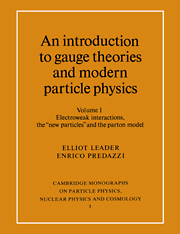Book contents
- Frontmatter
- Contents
- Preface
- Acknowledgements
- Notational conventions
- Note added in proof: the discovery of the top quark (?)
- Note added in proof: the demise of the SSC
- 1 Field theory and pre-gauge theory of weak interactions
- 2 The need for a gauge theory
- 3 Spontaneous symmetry breaking: the Goldstone theorem and the Higgs phenomenon
- 4 Construction of the standard model
- 5 Lowest order tests of the SM in the leptonic sector
- 6 The Higgs boson
- 7 The standard model beyond lowest order
- 8 e+e− physics and the standard model
- 9 Extension to the hadrons; quark–lepton universality
- 10 Phenomenology of semi-leptonic reactions
- 11 The discovery of the narrow vector resonances
- 12 Hidden flavour bound states
- 13 Open heavy flavours
- 14 The heavy lepton τ
- 15 Towards the parton model—deep inelastic scattering
- 16 The quark–parton model
- 17 Experimental tests of the quark-parton model
- Appendix 1 Elements of field theory
- Appendix 2 Feynman rules for QED, QCD and the SM
- Appendix 3 Conserved vector currents and their charges
- References
- Analytic subject index for vols. 1 and 2
16 - The quark–parton model
Published online by Cambridge University Press: 19 March 2010
- Frontmatter
- Contents
- Preface
- Acknowledgements
- Notational conventions
- Note added in proof: the discovery of the top quark (?)
- Note added in proof: the demise of the SSC
- 1 Field theory and pre-gauge theory of weak interactions
- 2 The need for a gauge theory
- 3 Spontaneous symmetry breaking: the Goldstone theorem and the Higgs phenomenon
- 4 Construction of the standard model
- 5 Lowest order tests of the SM in the leptonic sector
- 6 The Higgs boson
- 7 The standard model beyond lowest order
- 8 e+e− physics and the standard model
- 9 Extension to the hadrons; quark–lepton universality
- 10 Phenomenology of semi-leptonic reactions
- 11 The discovery of the narrow vector resonances
- 12 Hidden flavour bound states
- 13 Open heavy flavours
- 14 The heavy lepton τ
- 15 Towards the parton model—deep inelastic scattering
- 16 The quark–parton model
- 17 Experimental tests of the quark-parton model
- Appendix 1 Elements of field theory
- Appendix 2 Feynman rules for QED, QCD and the SM
- Appendix 3 Conserved vector currents and their charges
- References
- Analytic subject index for vols. 1 and 2
Summary
As with all theories of strong interactions things look simple to begin with, but as experimental accuracy improves models are forced to become increasingly complicated, with the continuous addition of new features much, it must be admitted, like the Ptolemaic cycles and epi-cycles of old. Thus the behaviour of the structure functions in deep inelastic lepton scattering will lead us initially to a simple picture of a hadron composed of granular constituents, partons. Soon thereafter we shall discover the need for antipartons and the beautiful association between partons and quarks. But the gross failure of the ‘momentum sum rules’ will indicate that some constituents are still missing; presumably the ‘gluons’. Although the gluons do not interact directly with the virtual photon used in our picture of deep inelastic scattering they are supposed to mediate the strong interactions and to give rise to the QCD corrections to the quark–parton model. These will be discussed in Chapters 20 and 21.
Finally we warn the reader that to meet the phenomenal accuracy of recent experiments it is necessary to give careful attention to kinematic details which to some extent detract from the elegant simplicity of the original picture. These effects are treated in the appendix to this chapter (Section 16.9) in which the parton model is reformulated as an impulse approximation which allows better control of the kinematic factors. The chapter can be perfectly well understood without reading the appendix.
The introduction of partons
We begin with a qualitative discussion of the quark-parton model. A more careful and quant it ive description is gradually developed thereafter.
- Type
- Chapter
- Information
- An Introduction to Gauge Theories and Modern Particle Physics , pp. 352 - 395Publisher: Cambridge University PressPrint publication year: 1996

